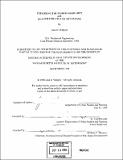Exploring the paired share REIT and quantifying its tax advantage
Author(s)
Walpole, Julie D., 1966-
DownloadFull printable version (4.479Mb)
Alternative title
Exploring the paired share real estate investment trust and quantifying its tax advantage
Other Contributors
Massachusetts Institute of Technology. Dept. of Urban Studies and Planning.
Advisor
W. Tod McGrath.
Terms of use
Metadata
Show full item recordAbstract
Real Estate Investment Trusts (REITs) were established in 1960 by Congress to open real estate investing to the small investor, in the same way that mutual funds have allowed small investors access to a diversified portfolio of stocks. As is the case with mutual funds, REITs enjoy a conduit status, allowing them to avoid corporate level taxation as long as they meet certain requirements. These requirements have been designed and legislated to ensure that REITs remains passive owners of real estate. As a passive owner of real estate, the traditional REIT vehicle is not ideally suited for an operationally intensive business, even those with a large real estate component (notably hotels, casinos, health care centers, and parking garages). Accordingly, variations of the REIT structure have emerged over time in an effort to benefit from the active business income generated through the operations of real estate holdings. One such variation is the Paired Share REIT. Conceived in 1977, and later banned from further formation in 1984, the structure has once again come under fire. Citing tax avoidance business practices that result in unfair competitive advantage, the Clinton Administration proposes to curb the use of the Paired Share structure on any new acquisitions by the five grandfathered Paired Share REITs that today still exist today. This thesis examines the Paired Share REIT structure and its perceived tax advantage. It concludes that while the Paired Share REIT structure can enjoy a tax advantage relative to a subchapter "C" corporation legislated REIT restrictions limit its financial flexibility. In addition, there are financial tactics available to the "C" corporation that can do much to mitigate these advantages. Two notable tactics are the use of the tax-shielding value of debt and the ability to retain earnings to fund growth. Further, it is concluded that the combined tax expense of the business entity and its shareholders does not differ significantly from the Paired Share REIT and the "C" corporation.
Description
Thesis (S.M.)--Massachusetts Institute of Technology, Dept. of Urban Studies and Planning, 1998. Includes bibliographical references.
Date issued
1998Department
Massachusetts Institute of Technology. Department of Urban Studies and PlanningPublisher
Massachusetts Institute of Technology
Keywords
Urban Studies and Planning.